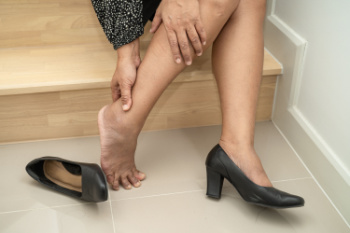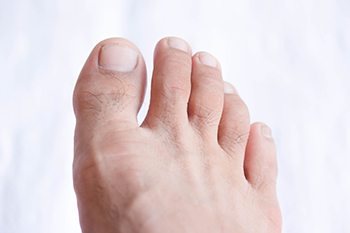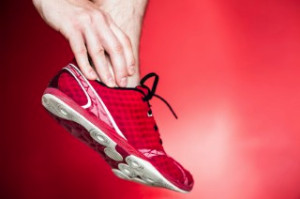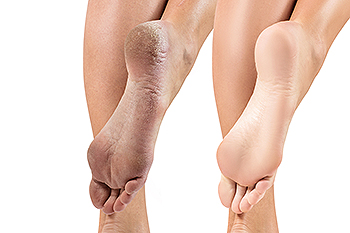Items filtered by date: January 2024
Foot Pain Management

Managing foot pain involves a comprehensive approach aimed at ensuring effective relief and long-term foot health. Initially, a precise diagnosis from a podiatrist is essential, which is achieved through a combination of medical history assessment, physical examination, and diagnostic tests such as X-rays or MRI scans. Once the underlying cause is identified, various forms of treatment can be considered. Custom-made orthotic inserts tailored to provide personalized support, correct gait abnormalities, and alleviate pressure on problem areas of the feet can be prescribed. Suggestions for appropriate shoes for needed arch support, cushioning, and fit might be given. Foot splints or braces can be beneficial for specific conditions, and surgical procedures are considered when conservative measures fail to address structural issues or severe pain. Lifestyle modifications, including weight management and activity adjustments, are emphasized to reduce stress on the feet. If you are suffering from foot pain, it is suggested that you schedule an appointment with a podiatrist to manage the pain, improve mobility, and enhance overall quality of life.
Foot Pain
Foot pain can be extremely painful and debilitating. If you have a foot pain, consult with Dr. Richard T. Bauer from Summit Foot & Ankle. Our doctor will assess your condition and provide you with quality foot and ankle treatment.
Causes
Foot pain is a very broad condition that could be caused by one or more ailments. The most common include:
- Bunions
- Hammertoes
- Plantar Fasciitis
- Bone Spurs
- Corns
- Tarsal Tunnel Syndrome
- Ingrown Toenails
- Arthritis (such as Gout, Rheumatoid, and Osteoarthritis)
- Flat Feet
- Injury (from stress fractures, broken toe, foot, ankle, Achilles tendon ruptures, and sprains)
- And more
Diagnosis
To figure out the cause of foot pain, podiatrists utilize several different methods. This can range from simple visual inspections and sensation tests to X-rays and MRI scans. Prior medical history, family medical history, and any recent physical traumatic events will all be taken into consideration for a proper diagnosis.
Treatment
Treatment depends upon the cause of the foot pain. Whether it is resting, staying off the foot, or having surgery; podiatrists have a number of treatment options available for foot pain.
If you have any questions, please feel free to contact our office located in Latham, NY . We offer the newest diagnostic and treatment technologies for all your foot care needs.
Arthritic Big Toe Surgery

Debilitating arthritis often affects the big toe, a condition referred to as hallux rigidus. In cases where conservative treatments fall short, cheilectomy surgery may be an option. This procedure aims to address the impact of arthritis by removing bone spurs that form on the top of the big toe. Bone spurs, or bony lumps, are a common result of hallux rigidus and can lead to pain and limited range of motion. The body produces these spurs as a protective measure to restrict movement, to alleviate arthritic pain. Those considering cheilectomy typically experience pain while wearing shoes and may view this surgery as a treatment option for early-stage arthritis of the big toe. Cheilectomy is a relatively simple foot operation, and most patients can expect a full recovery within six to eight weeks post-surgery. The primary objective of the procedure is to eliminate the bone spur, providing relief from pain and enhancing toe mobility. If you are grappling with persistent big toe pain or restricted movement, it is suggested that you consult with a podiatrist. This foot doctor can assess your condition and help determine whether a cheilectomy is a suitable solution.
Foot surgery is sometimes necessary to treat a foot ailment. To learn more, contact Dr. Richard T. Bauer of Summit Foot & Ankle. Our doctor will assist you with all of your foot and ankle needs.
When Is Surgery Necessary?
Foot and ankle surgery is generally reserved for cases in which less invasive, conservative procedures have failed to alleviate the problem. Some of the cases in which surgery may be necessary include:
- Removing foot deformities like bunions and bone spurs
- Severe arthritis that has caused bone issues
- Cosmetic reconstruction
What Types of Surgery Are There?
The type of surgery you receive will depend on the nature of the problem you have. Some of the possible surgeries include:
- Bunionectomy for painful bunions
- Surgical fusion for realignment of bones
- Neuropathy decompression surgery to treat nerve damage
Benefits of Surgery
Although surgery is usually a last resort, it can provide more complete pain relief compared to non-surgical methods and may allow you to finally resume full activity.
Surgical techniques have also become increasingly sophisticated. Techniques like endoscopic surgery allow for smaller incisions and faster recovery times.
If you have any questions please feel free to contact our office located in Latham, NY . We offer the newest diagnostic and treatment technologies for all your foot and ankle needs.
Heel Pain Can Be Treated!
Dietary Guidelines for Gout Management

Gout, a form of arthritis caused by the accumulation of uric acid crystals in the joints, often the big toe, requires careful attention to dietary choices to manage symptoms effectively. A key principle is moderating the intake of purine rich foods, as purines contribute to elevated uric acid levels. Reducing the consumption of organ meats, seafood, and certain legumes can help mitigate the risk of gout attacks. Adequate hydration is essential, as it supports the elimination of uric acid through urine. Incorporating low fat dairy products, which have been associated with a lower risk of gout, can be beneficial. Additionally, maintaining a healthy weight is vital, as excess weight can contribute to higher uric acid levels. Fruits, vegetables, and whole grains are encouraged, as they provide essential nutrients without significantly impacting uric acid levels. If you have developed gout, it is strongly suggested that you are under the care of a podiatrist who can effectively treat this condition, and guide you toward healthy food choices.
Gout is a foot condition that requires certain treatment and care. If you are seeking treatment, contact Dr. Richard T. Bauer from Summit Foot & Ankle. Our doctor will treat your foot and ankle needs.
What Is Gout?
Gout is a type of arthritis caused by a buildup of uric acid in the bloodstream. It often develops in the foot, especially the big toe area, although it can manifest in other parts of the body as well. Gout can make walking and standing very painful and is especially common in diabetics and the obese.
People typically get gout because of a poor diet. Genetic predisposition is also a factor. The children of parents who have had gout frequently have a chance of developing it themselves.
Gout can easily be identified by redness and inflammation of the big toe and the surrounding areas of the foot. Other symptoms include extreme fatigue, joint pain, and running high fevers. Sometimes corticosteroid drugs can be prescribed to treat gout, but the best way to combat this disease is to get more exercise and eat a better diet.
If you have any questions please feel free to contact our office located in Latham, NY . We offer the newest diagnostic and treatment technologies for all your foot and ankle needs.
Foot Care Tips for Athletes

Ensuring your feet are in top shape is paramount for athletes who aim to maximize their performance. Here are a few tips that can help athletes avoid injuries. When selecting workout shoes, prioritize support, stability, and cushioning. Avoid wearing ill-fitting options that may look pretty but can cause discomfort, pain, and pressure. Take the time to try different types and sizes until you find the perfect pair. Enhance protection with blister prevention spray for added comfort during workouts. Socks are more than just an accessory. Choose moisture-wicking options to keep feet clean and dry, thus preventing exposure to fungus and bacteria. To prevent foot injuries, be mindful of overexertion and listen to your body's limits. Incorporate strengthening exercises like yoga or try toe stretchers for a relaxing foot yoga session. Proactively address foot pain with gentle stretches, warm-ups, and cool-downs. Maintain foot hygiene by washing and drying your feet daily, using cleansing towelettes, and spritzing with odor elimination spray pre- and post-workout. If you are experiencing foot or ankle problems related to sports or exercise, it is suggested that you schedule an appointment with a podiatrist.
All runners should take extra precaution when trying to avoid injury. If you have any concerns about your feet, contact Dr. Richard T. Bauer of Summit Foot & Ankle. Our doctor will treat your foot and ankle needs.
How to Prevent Running Injuries
There are a lot of mistakes a runner can make prior to a workout that can induce injury. A lot of athletes tend to overstretch before running, instead of saving those workouts for a post-run routine. Deep lunges and hand-to-toe hamstring pulls should be performed after a workout instead of during a warmup. Another common mistake is jumping into an intense routine before your body is physically prepared for it. You should try to ease your way into long-distance running instead of forcing yourself to rush into it.
More Tips for Preventing Injury
- Incorporate Strength Training into Workouts - This will help improve the body’s overall athleticism
- Improve and Maintain Your Flexibility – Stretching everyday will help improve overall performance
- “Warm Up” Before Running and “Cool Down” Afterward – A warm up of 5-10 minutes helps get rid of lactic acid in the muscles and prevents delayed muscle soreness
- Cross-Training is Crucial
- Wear Proper Running Shoes
- Have a Formal Gait Analysis – Poor biomechanics can easily cause injury
If you have any questions, please feel free to contact our office located in Latham, NY . We offer the newest diagnostic and treatment technologies for all your foot care needs.
Why Do Cracked Heels Develop?

Cracked heels, a prevalent foot ailment, unfold as a result of a combination of factors intricately linked to foot care and lifestyle. The skin on the heels is naturally drier and thicker, making it prone to dehydration, especially in areas with low humidity or during seasons such as winter. Lack of proper hydration and moisturization contributes significantly to the development of cracked heels. Prolonged standing or walking on hard surfaces adds to the pressure on the feet, leading to the formation of calluses that may eventually crack. Wearing ill-fitting footwear, with open-back shoes being a common factor, exposes the heels to friction and worsens the condition. Medical conditions like eczema, psoriasis, or thyroid disorders can also contribute to skin dryness, increasing the risk of cracked heels. If you have developed problematic cracked heels, it is suggested that you consult a podiatrist who can offer you effective relief options, which may include prescribed medicine.
Cracked heels are unsightly and can cause further damage to your shoes and feet. If you have any concerns, contact Dr. Richard T. Bauer from Summit Foot & Ankle. Our doctor can provide the care you need to keep you pain-free and on your feet.
Cracked Heels
Cracked heels appear unappealing and can make it harder for you walk around in sandals. Aside from looking unpleasant, cracked heels can also tear stockings, socks, and wear out your shoes. There are several methods to help restore a cracked heel and prevent further damage.
How Do You Get Them?
Dry skin is the number one culprit in creating cracked heels. Many athletes, walkers, joggers, and even swimmers suffer from cracked heels. Age and skin oil production play a role to getting cracked heels as well.
Promote Healing
Over the counter medicines can help, especially for those that need instant relief or who suffer from chronic dry feet.
Wear Socks – Wearing socks with medicated creams helps lock in moisture.
Moisturizers – Applying both day and night will help alleviate dryness which causes cracking.
Pumice Stones – These exfoliate and remove dead skin, which allows for smoother moisturizer application and better absorption into the skin.
Change in Diet
Eating healthy with a well-balanced diet will give the skin a fresh and radiant look. Your body responds to the kinds of food you ingest. Omega-3 fatty acids and zinc supplements can also revitalize skin tissue.
Most importantly, seek professional help if unsure how to proceed in treating cracked heels. A podiatrist will help you with any questions or information needed.
If you have any questions, please feel free to contact our office located in Latham, NY . We offer the newest diagnostic and treatment technologies for all your foot care needs.

